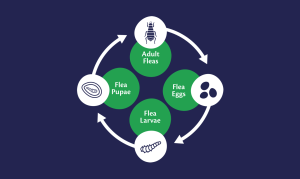Fleas and ticks can be a particular problem for dogs and dog owners alike.

Although they’re an issue for all pets, fleas and ticks can be a particular problem for our pooches. That’s because fleas and ticks thrive in areas where dogs love to explore, with long grass and a warm, damp climate both of their favourite stomping grounds.
Whilst cats will more likely catch fleas by socialising outside, our dogs will most likely catch them on walks in local parks, fields and countryside.
What’s the difference between fleas and ticks?
Fleas are small blood sucking parasites which feed on animals. Because they’re wingless, their main way of getting around is by jumping – sometimes distances of 100 times their own body length. Although that sounds pretty impressive, they’ll jump onto your pet or even you whilst you’re out on a walk and once they’ve latched on, they’ll then start feeding.
They can be hard to spot, but if you see fleas on your pet then they’ll definitely be in your home too. Even just one female flea can lay up to 50 eggs a day, meaning a single flea can easily infest your pet and your home.
In addition to making your pet uncomfortable, fleas can also lead to flea allergy dermatitis and even anaemia. Fleas can also carry tapeworm larvae, which your pet can become infested by accidentally ingesting fleas whilst grooming themselves.
And although ticks won’t necessarily infest your home, they can be just as menacing and can be potentially dangerous as they can spread blood borne diseases after they’ve latched onto your pet and sucked their blood for hours at a time.
Symptoms of fleas and ticks on dogs
Fleas can be an itchy pain. That’s why repeated scratching is often the first sign of an infestation, with constant itching also leading to hair loss or irritated skin which can be another sign. They’re really small (often the size of a poppy seed) so can be hard to spot, but you might see them on their fur or if you use a flea comb.
Ticks can cause Lyme Disease in both humans and dogs – a potentially life threatening illness. Symptoms of the disease in dogs can include lethargy, loss of appetite, lameness and fever. You should speak to your vet if your dog shows these signs.
How to check your dog for fleas and ticks
If you live in a tick-prevalent area it’s worth checking your pet regularly by running your fingers through their coat feeling for a little lump, look inside their ears and between their toes. They are usually quite easy to see and feel.
Check your pet for fleas on the neck area, behind the ears, at the base of the tail and fur on the tummy. Place your pet on some white paper, then comb them with a flea comb. Flecks of black which change to red when you wet the paper is evidence of flea dirt.
What do flea eggs look like?
While adult fleas might be fairly easy to spot, flea eggs can be less obvious. Flea eggs are almost microscopic and are typically around 0.5 millimetres in length. Flea eggs can be identified by their soft shell and off-white colour, similar in look and size to a grain of salt.
How do dogs get fleas?
One of the most common ways dogs will catch fleas is from contact with other animals and the environment. Fleas can jump from other pets and wildlife onto your dog and bring them home after a walk in the park.
Can dog fleas live on humans?
While there are many different types of flea, some of which can live on humans, dog fleas will prefer your pet to you. However, you might still suffer from flea bites even if they can’t live survive on your skin.
How to treat and prevent fleas and ticks on your dog and in the home
If you find a tick on your pet, it’s best to remove it as soon as possible as it can spread disease. If you’ve never removed a tick before, or you’re unsure how to do it, you should consult your vet who can show you – if you don’t remove the tick properly you risk leaving the head buried beneath the skin, which can result in a nasty abscess.
Most pet owners know they should treat their cat or dog for fleas and ticks on a regular basis. But did you know that the fleas you see on your pet only makes up 5% of the flea infestation? The remaining 95% are in the home.
The importance of treatment when it comes to fleas and ticks in the home
Making sure you treat both your pet and your home is a vital step, because it will ensure you treat the whole problem and fully eradicate them.
To provide complete protection for your pet and your home, your flea treatments need to include two ingredients: an insecticide to kill the adult fleas and an Insect Growth Regulator (IGR) which targets flea eggs and flea larvae and stops their life cycle.
How long do fleas live? The Flea life cycle:

If you’ve spotted fleas or ticks, it’s really important to introduce a treatment product routine, as soon as possible:
If you’ve spotted fleas:
Step 1: Treat your dog for fleas with a fast-acting treatment
Step 2: Then treat your home with a Bob Martin Home flea product (such as a spray, fogger or powder) and then vacuum, before washing your bedding and spraying your home with preventive treatments.
If you find a tick on your pet, it’s best to remove it as soon as possible as it can spread disease. If you’ve never removed a tick before, or you’re unsure how to do it, you should consult your vet who can show you – if you don’t remove the tick properly you risk leaving the head buried beneath the skin, which can result in a nasty abscess.
The Bob Martin Clear and Clear Plus range of spot ons and tablet treatments for your dog, alongside Bob Martin Clear Home Sprays, Foggers, Powders or Bombs, will kill fleas and flea eggs, ticks and dust mites, protect your home for up to 12 months by breaking the flea’s life cycle.
Bob Martin Clear Plus not only kills adult fleas and ticks, but also kills flea eggs on your pet and in the immediate surroundings, to stop them developing into larvae, pupae and then back into an adult flea again.
Prevent them from coming back into your home
And if your home and your pet aren’t infested with fleas, and you (quite rightly) want to keep it that way, you should then use our Bob Martin Clear Prevention range:
✔ Repels fleas and ticks throughout the year
✔ Used for both pet and home
✔ Pesticide free and made with all natural ingredients
✔ Provides pet & home protection throughout the year
Although spring and summer will bring an explosion in numbers, fleas can continue to live inside our homes throughout the year, due to our warm, centrally heated houses. That’s why it’s really important to treat at-need whilst also continuing to prevent throughout the year.
For more information on the difference between treatment and prevention.

